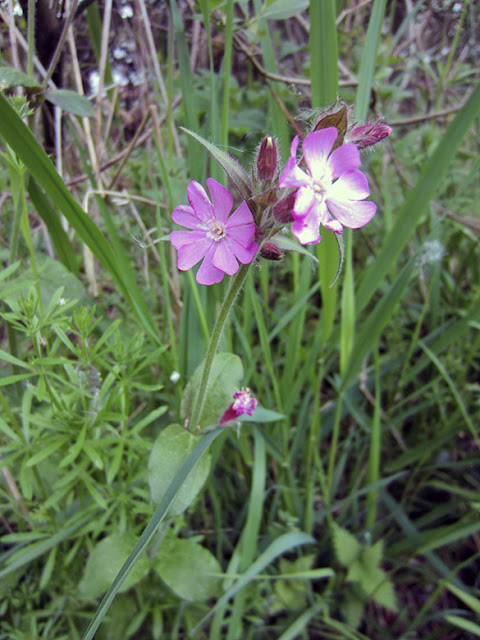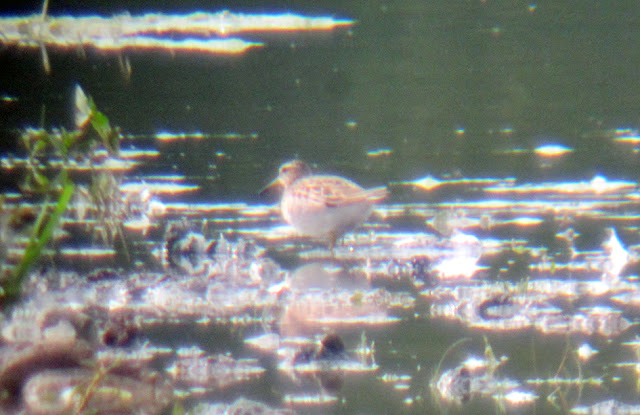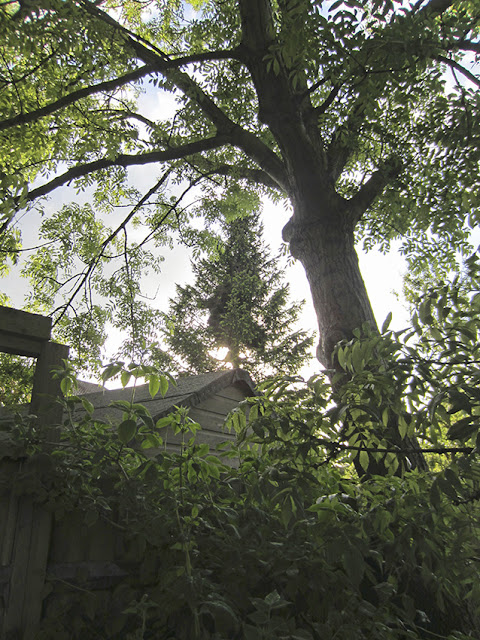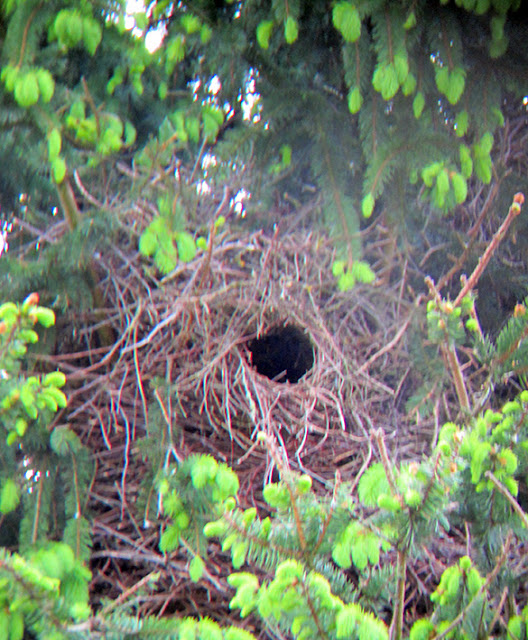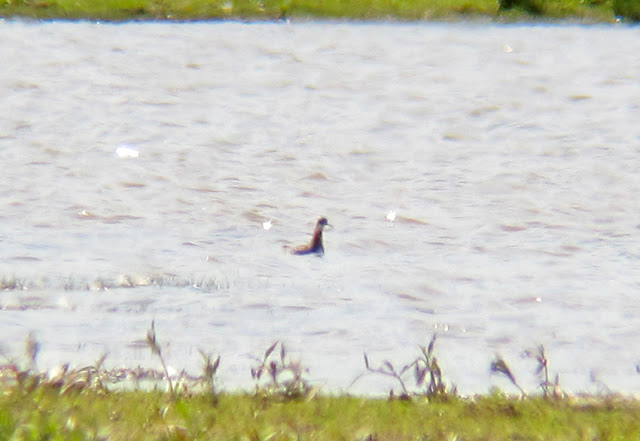As on the trip three weeks earlier, I met with Mike and Chris in Falkirk on the Friday evening. Day 1 started with ten Black Grouse on Braco Moor.

Black Grouse lekking, Braco Moor, Perth & Kinross - Saturday 25th May 2013
We have a winner!
Plenty of Whinchat around, plus the expected Common Gull, Meadow Pipit, Oystercatcher, Snipe, Curlew, Willow Warbler, etc. We made our way to Loch of Lowes, getting some better views of Whinchat, Common Whitethroat, and Garden Warbler on route, and more Black and Red Grouse. House Martins seem to be doing okay here.
The Osprey nest at Loch of the Lowes was occupied, but they weren’t giving their best views while I was in the hide. Better was around the feeding station: smart Siskin, Lesser Redpoll and Yellowhammer the highlights.
Our plan was to catch the ferry to Lochmaddy (North Uist) from Uig (Skye) at midday. But we’d left it late and had to dash across country to get to the terminal in time. We hadn’t booked tickets, which meant for an anxious wait to see if they’d let us on (this kind of unavoidable drama is usual for trips with Lee!). We spent our time scanning the harbour: Black Guillemot, Razorbill, lots of Shag, and a double-figure group of Red-breasted Merganser washing in the shallows. The weather wasn’t too bad, overcast and chilly, but okay. Word was the weather on North Uist was poor, which didn’t help our chances of seeing any eagles or the much-wanted Snowy Owl.
We were allowed on board, and spent the trip sea-watching as it became gradually colder: a large numbers of Puffin, Razorbill and Guillemot, a few Arctic Tern, Fulmar and Kittiwake, the odd Great Skua, and a Manx Shearwater.
We took the northern road around North Uist, going via Solas. At Grenitote a Glaucous Gull landed in front of us as we were watching Little Tern, Knot, Bar-tailed Godwit, Shoveler, and a female Hen Harrier pass through. It had started raining and was getting worse, so headed off to Balranald, further west.
We parked at the sea-watching site and Lee lead us over a hill to a lochan where a Cackling Goose was swimming around, happy as Larry in glorious isolation. This was the Cackling Goose (or Richardson’s Canada Goose) I’d spent hours looking for in early March. Result!
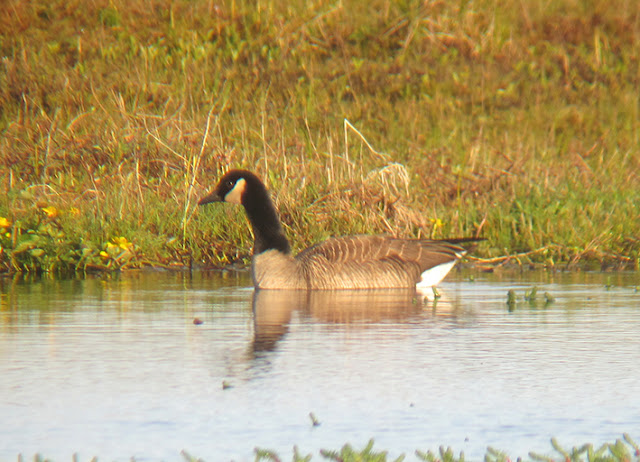

Richardson's Canada Goose, Balranald, North Uist - Sunday 26th May 2013
There were lots of Eider and a fantastic Great Northern Diver close in on the sea, with three Little Gull riding the wind with other gulls. Further down the beach we saw a bird I was already acquainted with: a young male Harlequin Duck.
Also on the reserve: Whooper Swan, Shelduck, Snipe, Sanderling, more Bar-tails, Twite, Corn Bunting, and a couple of passing Pomarine Skua picked out by Craig. Balranald was a different reserve to the one I visited just a few weeks earlier. So nice we came back the following morning…
Sunrise at Lochmaddy, North Uist - Sunday 26th May 2013
Day 2 and we were back at Balranald listening for Corncrake. We heard them ok, but got no views. We did get to get on to a Ruff, hidden in the long grass, thanks to a fellow birder letting us look through his scope (all adding to the trip list). The weather was much better now, allowing me to take some shots of the goose and to do some sea-watching. Craig and Lee got on to a distant skua heading north – very, very long-tailed, with long, thin wings, a slight tern-like action, and a meandering rather than direct flight: a Long-tailed Skua. Excellent, two lifers in two days.
Balranald RSPB, North Uist - Sunday 26th May 2013

Corn Bunting, Balranald, North Uist - Sunday 26th May 2013
The group’s focus (or rather Lee’s focus) seemed to be more on Corncrake than Snowy Owl, which wound me up somewhat. But, the views we had of a Corncrake stood on a dry stone wall perked me up. We made some cursory attempts at the Snowy Owl (which, with hindsight, probably had left overnight), finding only Golden Plover, Ringed Plover, Dunlin, Sanderling, etc, between the machair and the sea.
We had a date with the ferry, and while in the car park I picked up some distant raptors. One really struck me as different – a White-tailed Eagle. It circled and drifted in our direction, eventually passing low directly over our heads, looking like a floorboard with a bird strapped to it. An awesome sight.
Lochmaddy-Uig ferry
I enjoyed the boat trip back to Skye, picking out Manx Shearwater, and large numbers of Arctic Tern among the other sea birds, and Buzzard and a pair of Raven over Uig harbour.
We spent the morning touring Skye, the highlight being a group of Mealy Redpoll coming to feeder in a garden on the north of the island (near where we saw some last year). Making our way over to Grantown-on-Spey for the night – Black-throated Diver and Slavonian Grebe on lochs on route.
Day 3 – Another 5am meet and more great views of the rogue Capercaillie in Abernethy Forest (the same chap as three weeks earlier). It was lekking close to the road, allowing the photographers to get some great shots.
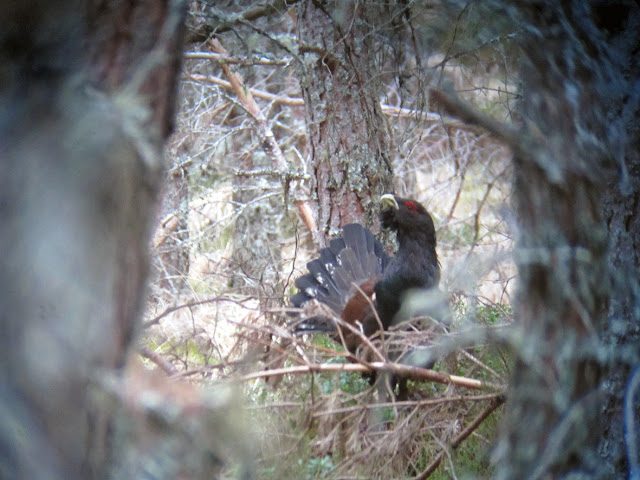
Capercaillie, Abernethy Forest, Highland - Monday 27th May 2013

Who says photographers always want to get too close?
Beetle, Abernethy Forest, Highland - Monday 27th May 2013
Wood Ant nest, Abernethy Forest, Highland - Monday 27th May 2013
After breakfast we headed back towards Loch Garten RSPB, getting Dipper on the Spey. We all had some good views of Osprey and Crested Tit, then the photographers in the group wanted more Caper action, so went back for seconds. According to the video I’ve seen, someone may have got a little too close for comfort – though it was the bird approaching him, rather than the other way round!The rest of the day was spent in the Aviemore area, getting some nice Osprey views and adding Goldeneye to the trip list.
Osprey, Aviemore - Monday 27th May 2013
We started Day 4 with a lie-in, meeting at 6am and heading to Anagach Forest. Craig picked up a Pine Martin, but most of couldn’t get on to it. The weather was a bit cold and overcast, which probably led to it being a quiet session for birds: singing Tree Pipit, Redstart, Mistle Thrush, and Willow Warbler where the highlights, among all the Chaffinches.
After brekkie some us headed up Sneachda from Cairngorms Ski Centre, looking for Ptarmigan. Although I’d seen these really well three weeks earlier, I’d never pass up the chance to see them again – I mean, these are a real Scottish speciality and we (Englanders) don’t get chance to see them at home. I’m glad I did go too: we had some great views. We couldn’t go too far because the weather up top was bad, but the area just below the snow line and mist was best for Ptarmigan anyhow. We had some nice Red Grouse on the way up and down too, and a pair of Ring Ouzel carrying food by the car park.
Ptarmigan, Ben MacDui, Aviemore, Highland - Tuesday 28th May 2013
Time to turn back...
On the way down..
We spent the afternoon at the upper end of Findhorn Valley. This is a traditional site for Golden Eagle, and we weren’t disappointed, with one flying right over us, shortly after being mobbed by a Peregrine. A few Buzzards around too for a handy size comparison.
Then we started heading south, and called it at one of my favourite sites: Killiecrankie near Pitlochry. It was lovely warm evening now, and we walked further along the River Garry than we have in recent visits. My birding sense was switched on (for once on this trip), and I managed to find us a Spotted Flycatcher feeding over the river, before picking out a female Pied Flycatcher after we’d heard a male singing nearby. A couple of Wood Warbler were singing their awesome song too. I got chatting to some other birders and they helped me find a pair of Dipper feeding three recently fledged chicks, and tell us about some nearby Osprey. Garden Warbler, Pied and Grey Wagtails on the river, Great Spotted Woodpeckers… excellent site. Well worth calling in if you’re passing during the spring/summer.
We went past Bonskeid House, a former YMCA centre where I’d stayed with my mum in the summer of 1979. Brought back loads of memories of walks, bird watching and eating chocolate... It reminded me just how ace my mum was and how much I still miss her after all these years.
We ended the day at Musselburgh, adding Common and Velvet Scoter, Sandwich Tern and Grey Plover to the trip list. We had a heated debate in the car park of the Premier Inn at Musselburgh (it was full), during which I drank Peroni in the bar. We decided to split up for the night (Mike’s car to Falkirk and Lee’s to Berwick-on-Tweed)…
Wednesday (Day 5) and we started the day trying to see the terns on Coquet Island from the mainland. It’s doable, but not in strong winds with gusts and heavy rain. I nearly got hit in the face by a Fulmar, which – while great – illustrates the type of weather we were up against.
We knocked about Druridge Bay for a while, seeing Spoonbill and Common Terns (no doubt nesting on Coquet Island) feeding at Hauxley NWT, and a nice pair of Stonechat and Sedge Warbler at East Chevington. We called at Seaton Common in Cleveland (near Saltholme RSPB) for a Great White Egret (and got the bonus of a brief Yellow Wagtail), but the weather wasn’t improving so we headed south… to Lakenheath Fen in Suffolk.
The prize here was Savi’s Warbler and we were treated to some good views of it in lovely weather as it sang in the reeds about 20 metres away. While easy to see with the scope, it was very difficult to digiscope, so my best photo is pretty crap. It was nice to compare the Savi’s song with a Grasshopper Warbler singing nearby. The former sounding like a tiny motor, the latter being a smoother, thinner noise, like a freewheeling bike.
Savi's Warbler, Lakenheath RSPB, Suffolk - Wednesday 29th May 2013
There were lots of Groppers dotted around the reserve, as were Sedge and Reed Warblers. I lost count of the number of Cetti’s Warbler and Cuckoo I heard. A bonus was a Common Crane in a field across the river (in Norfolk).
We had our latest start - 7am - on Thursday (Day 6), not surprising after that long drive on Wednesday. The bad weather had caught up with us and we headed back to Lakenheath in the rain. We had more good views of Savi’s and Grasshopper Warblers, and Common Crane, and a low-flying Bittern. Nearby we had our first Grey Partridge of the trip, before calling in at Weeting NWT for a Stone Curlew after a 10 minute wait (we didn’t have to wait all day like I did for my first here in 2008).
We headed north to Titchwell Marsh on the Norfolk coast, seeing our first Red-legged Partridge of the trip on the way. We arrive at 10am, no bad, given the late start. Titchwell rarely disappoints, and this was another enjoyable visit. Highlights and new birds for the trip were Black-tailed Godwits, Avocets (they’re taking over), Little Egret (taking til now to get one), Garganey, Teal (again, taken us all week before we came across these), Red-crested Pochard, Dark-bellied Brent Goose, Mediterranean Gull (three beautiful adults flying low over), and Little Gull (wonderful views of adults and sub-adults – such a great bird to watch). The Little Stint we thought we had turned out to be a Sanderling – think there were some crossed wires there.
The weather turned cooler in the afternoon, as we went in search of Montagu’s Harrier. We were not disappointed. After the warm up acts of Red Kite, Buzzard, Sparrowhawk, Hobby, and a pair of Marsh Harriers exchanging a rabbit mid-air, the male Monty flew in. He hunted over the field for a short while before coming to rest on a farm track. The female joined him soon after. A real highlight of the trip. Watching a Lesser Whitethroat carrying food to a nearby hedge for the hour we were there was a nice bonus.
We had Greylags and Egyptian Geese at Holkham as we headed to Kelling Heath for Woodlark and Turtle Dove. We checked in to our various B&Bs in Sheringham and had a great Thai meal, arranged as ever by Chris M. I was a bit tipsy when we were out looking for Nightingale, but we (the group in Mike’s car) did get a brief glimpse after we all had heard one sing.
Friday 31st May (Day 7) was an even later start – 8am. The sea mist was covering the whole of the North Norfolk Coast, so there was no rush. It was cold when we did eventually venture out into Sheringham Country Park, but we managed some lovely views of Firecrest and Nuthatch. We failed to see the summering Pick-foot and Whitefronts at Holkham again, as we headed for a second stab at Titchwell. Today’s target was Temminck’s Stint. The weather improved and we were getting some heat haze when watching the tiny stint. Little Ringed Plover was another addition.
News came through of a Short-toed Lark on Blakeney Point, a life for most of us and a year tick for all. Parking at Cley coastguards we set off on the yomp to the Marrams as fast as we could. Every birder we met coming back said they’d dipped it, but there were Wryneck and Black Redstart about. We soldiered on and found the lovely female Black Redstart in the blue boat.
Blakeney Point, Norfolk - Friday 31st May 2013
We tried in vain to see one of the Wryneck (although I did see a brown, woodpecker-shaped bird glide into some Suaeda in the area one had been seen, which was almost certainly a Wryneck, but not enough for a positive ID). I enjoyed watching the Little and Sandwich Terns, but as the sun beat down and I rued bringing my coat, I started taking a closer look at the plants.
Red-tailed Bumblebee on Common Birds-foot Trefoil - Blakeney Point
Sea Campion - Blakeney Point
Sea Campion - Blakeney Point
Sea Kale - Blakeney Point
Thrift (Sea Pink) - Blakeney Point
Thrift (Sea Pink) - Blakeney Point
Whelk egg sacs - Blakeney Point
We had started to trudge back when a call came from Brian Bland, the be-sandled birder we’d bumped into a few time in Norfolk. The Short-toed Lark was there on the shingle, just over the cordon protecting the Little Tern nests! Result! We all got good views, with the photographers getting a couple of shots off, before it flew high west along the point, where we lost it in the glare of the sun. A really interesting bird - very pale upperparts, making it difficult to see against the shingle. The unmarked breast was a key feature too, though we didn’t have long to study it. It ran in short bursts, allowing us quick stationary views, then flew off before any other birders could get a look.
Well now, that cheered us up, and we headed to Burnham Overy Staithe for a beautiful male Red-backed Shrike with a Barn Owl hunting behind in the sunshine. At Holkham, our last site of the day, were two Greenshank and two Whimbrel calling as they flew over from the south heading straight out over Holkham Pines.
We stayed in Sheringham again, though this time at the YHA – basic but cheap, just what we needed. Day 8 started at 7am, and we soon scored a local Dartford Warbler. We didn’t have much time before news broke of a White-spotted Bluethroat at nearby Cley. We piled down the East Bank and had nice scope views of a male singing from the willows out in the reeds to the west. The white area in the blue feathers on the throat were clear to see as the bird sing its heart out.
Watching the Bluethroat from the East Bank, Cley, Norfolk - a cold Saturday 1st June 2013
Sculthorpe NR was the next destination – a nice reserve, one of my favourites in Norfolk. We were after Marsh Tit, a speciality here. We all added Bullfinch to our trip lists first, before heading out to the Marsh Hide, overlooking the reedbed. The Marsh Harriers entertained us until a Marsh Tit showed up, right on cue. This is where we said goodbye to Chris M – no point in him going off south when we were so close to his house. Top bloke.
Marsh Harrier sculpture - Sculthorpe, Norfolk
Cowslip - Sculthorpe, Norfolk
Greater Stitchwort - Sculthorpe, Norfolk
Red Campion - Sculthorpe, Norfolk
Our last call in Norfolk was Abbey Farm, Flitcham, for Little Owl, before Welney WWT in Cambridgeshire for Whooper Swan (after I’d fallen off a gate – not the first time). We then headed for Berry Fen RSPB. The quarry here was Pectoral Sandpiper, which simply eluded us for ages. A pair of Garganey was a nice find, and it was only as we were leaving that I chanced upon a small wader among some sleeping duck – the Pectoral Sandpiper.
Pectoral Sandpiper, Berry Fen RSPB - Saturday 1st June 2013
We tried for a nearby Red-footed Falcon, but could only pick out distant Hobbies, so we headed south. The two cars became separated, which meant we (in Mike’s car) didn’t get the feral Barnacle Geese off the A1 – this did not unduly bother us! In London, the Ring-necked Parakeet is an easy bird to see and hear, but we had the bonus (if you can call it that) of seeing breeding Monk Parakeets. These are the same species I see regularly on trips to Barcelona, but it was novel to see them, and their nests, in London. Couldn’t manage a photo of one, unfortunately.
Monk Parakeet nests, Greater London - Saturday 1st June 2013
Breeding Black-necked Grebe are always nice to see, so to see a dozen on a reservoir was real treat. No Rudy Duck around though… Last call of the day was Chobham Common NNR. Woodcock were everywhere. We heard a distant Cuckoo and then a close Nightjar. It flew past us and landed in a tree. Despite some serious eyeballing, we couldn’t actually see it in the tree until it flew out again. Another successful day, rounded off my a margarita at Mike’s house – cheers for letting us stay Mike.
Chobham Common, Surrey - Saturday 1st June 2013
The last day (Day 9) started with a Kingfisher twitch in west London somewhere (yes, I know). I didn’t get on to it as it flew, but told everyone I did, so they didn’t have to hang around. Cracking birds, but we were now just trying to get the trip list up. We headed for the New Forest, in glorious weather. Perfect for Honey Buzzard and Goshawk, and so it proved. We had up to four Honey Buzzard, with two males performing wing quivering displays! One of the three (or more?) Goshawk was right over our heads at one point. The bulk of the bird and the fluffed out white undertail coverts were so obvious.
We wandered around the forest for a while, getting great views of a singing male Redstart and Wood Warbler. A Green Woodpecker nearly flew into my face while I was taking a discrete tinkle in the woods too…
This is where we had to split up – young Chris needed to be in the north west by the end of the day, and I needed to be further north, so while the others went in search of Hawfinch, Mike, Andy, young Chris and I went to Coombe Hill near Tewksbury for a female Red-necked Phalarope (don’t laugh at my photo, it was distant in some serious heat haze!).
Red-necked Phalarope, Coombe Hill NR, Gloucestershire - Sunday 2nd June 2013
Ringed Plover, Little Ringed Plover, and Little Gull were also present, and that wrapped up our birding. All that remained was to say goodbye – I spent the week with some top people and great birders on this trip.
The group as a whole got 208 species (heard and seen), whereas my personal total was 203 (199 seen, plus four heard-only). Not bad. Not bad at all. My full list below:
Red-throated Diver
Black-throated Diver
Great Northern Diver
Slavonain Grebe
Black-necked Grebe
Little Grebe
Great Crested Grebe
Northern Fulmar
Manx Shearwater
Northern Gannet
Atlantic Great Cormorant (and Continental Cormorant Sinensis)
Shag
Eurasian Bittern
Little Egret
Great White Egret
Grey Heron
Eurasian Spoonbill
Mute Swan
Whooper Swan
Greylag Goose
Greater Canada Goose
Cackling or Lesser Canada Goose (hutchinsii)
Dark-bellied Brent Goose
Common Shelduck
Egyptian Goose
Mandarin Duck
Mallard
Gadwall
Shoveler
Eurasian Wigeon
Common Teal
Garganey
Northern Pochard
Red-crested Pochard
Tufted Duck
Harlequin Duck
Common Eider
Common Scoter
Velvet Scoter
Long-tailed Duck
Common Goldeneye
Red-breasted Merganser
White-tailed Sea Eagle
Osprey
Golden Eagle
Red Kite
Marsh Harrier
Hen Harrier
Montagu's Harrier
Common Buzzard
Honey Buzzard
Sparrowhawk
Northern Goshawk
Common Kestrel
Hobby
Peregrine
Red Grouse
Ptarmigan
Capercaillie
Black Grouse
Red-legged Partridge
Grey Partridge
Corncrake
Common Pheasant
Moorhen
Coot
Common Crane
Oystercatcher
Avocet
Stone Curlew
Little Ringed Plover
Ringed Plover
Grey Plover
European Golden Plover
Lapwing
Red Knot
Sanderling
Turnstone
Dunlin
Common Redshank
Common Greenshank
Black-tailed Godwit
Bar-tailed Godwit
Eurasian Curlew
Whimbrel
Woodcock
Common Snipe
Red-necked Phalarope
Ruff
Great Skua
Pomarine Skua
Long-tailed Skua
Black-headed Gull
Common Gull
Mediterranean Gull
Herring Gull
Lesser Black-backed Gull
Great Black-backed Gull
Little Gull
Kittiwake
Little Tern
Sandwich Tern
Common Tern
Arctic Tern
Puffin
Black Guillemot
Common Guillemot
Razorbill
Rock Dove
Stock Dove
Woodpigeon
Collared Dove
Turtle Dove
Common Cuckoo (heard only)
Tawny Owl (heard only)
Short-eared Owl
Barn Owl
Little Owl
European Nightjar
Common Swift
Ring-necked Parakeet (plus Monk Parakeet)
Green Woodpecker
Great Spotted Woodpecker
Skylark
Woodlark
Greater Short-toed Lark
Sand Martin
Barn Swallow
House Martin
Meadow Pipit
Tree Pipit
Pied Wagtail
Yellow Wagtail
Grey Wagtail
Wren
Dipper
Dunnock
Robin
Common Nightingale
Common Redstart
Black Redstart
Whinchat
Common Stonechat
Song Thrush
Mistle Thrush
Common Blackbird
Ring Ouzel
Garden Warbler
Blackcap (heard only!)
Lesser Whitethroat
Common Whitethroat
Dartford Warbler
Sedge Warbler
Grasshopper Warbler
Cetti's Warbler (heard only)
Reed Warbler
Willow Warbler
Wood Warbler
Common Chiffchaff
Goldcrest
Firecrest
Spotted Flycatcher
Pied Flycatcher
Great Tit
Coal Tit
Blue Tit
Crested Tit
Marsh Tit
Long-tailed Tit
Nuthatch
Common Treecreeper
Red-backed Shrike
Common Magpie
Jay
Jackdaw
Rook
Carrion Crow
Hooded Crow
Common Raven
Common Starling
House Sparrow
Tree Sparrow
Chaffinch
Linnet
Twite
Lesser Redpoll
Mealy Redpoll
Goldfinch
Greenfinch
Siskin
Bullfinch
Reed Bunting
Yellowhammer
Corn Bunting
























